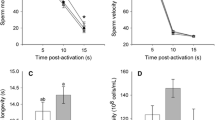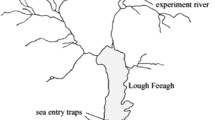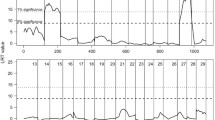Abstract
Inbreeding has negative effects on individual and population performances. Therefore, enhancement of offspring genetic diversity is believed to play a major role in shaping mating systems. However, no study has clearly separated the direct effect of having multiple partners from the indirect effect of having more outbred offspring on the resulting reproductive success of individuals in the wild. In this study, we report significant associations between both multiple mating and within-individual genetic diversity of offspring, and an increased reproductive success of wild female Atlantic salmon, Salmo salar. Specifically, we found that females with a higher number of mates also have more outbred offspring (within-individuals), and that both of these characteristics increased their reproductive success expressed in terms of offspring surviving when combining all freshwater juvenile stages. Our findings also indicate that determinants of fitness are different among sexes as within-individual offspring genetic diversity was not a strong predictor of male reproductive success, while the number of mates was important. We also show that females mated with more outbred males than on average, which potentially increased their chances of producing outbred offspring. These results therefore suggest that there could be more important indirect genetic benefits of multiple mating for females than for males.


Similar content being viewed by others
References
Acedevo-Whitehouse K, Gulland F, Greig D, Amos W (2003) Disease susceptibility in California sea lions. Nature 422:35
Aeschlimann PB, Haberli MA, Reusch TBH, Boehm T, Milinski M (2003) Female sticklebacks Gasterosteus aculeatus use self-reference to optimize MHC allele number during mate selection. Behav Ecol Sociobiol 54:119–126
Amos W, Worthington Wilmer J, Fullard K, Burg T, Croxall JP, Bloch D, Coulson T (2001) The influence of parental relatedness on reproductive success. Proc R Soc Lond B 268:2021–2028
Aubin-Horth N, Dodson JJ (2004) Influence of individual body size and variable thresholds on the incidence of a sneaker male reproductive tactic in Atlantic salmon. Evolution 58:136–144
Bateman AJ (1948) Intra-sexual selection in Drosophila. Heredity 2:349–368
Blomqvist D, Andersson M, Küpper C, Cuthill IC, Kis J, Lanctot RB, Sandercock BK, Székely T, Wallander J, Kempenaers B (2002) Genetic similarity between mates and extra-pair parentage in three species of shorebirds. Nature 419:613–615
Brown JL (1997) A theory of mate choice based on heterozygosity. Behav Ecol 8:60–65
Brown J, Brown E (1998) Are inbred offspring less fit? Survival in a natural population of Mexican jays. Behav Ecol 9:60–63
Coltman DW, Slate J (2003) Microsatellites measures of inbreeding: a meta-analysis. Evolution 57:971–983
Crnokrak P, Roff DA (1999) Inbreeding depression in the wild. Heredity 83:260–270
Duchesne P, Godbout MH, Bernatchez L (2002) PAPA (package for the analysis of parental allocation): a computer program for simulated and real parental allocation. Mol Ecol Notes 2:191–193
Foerster K, Delhey K, Johnsen A, Lifjeld JT, Kempenaers B (2003) Females increase offspring heterozygosity and fitness through extra-pair matings. Nature 425:714–717
Garant D, Dodson JJ, Bernatchez L (2000) Ecological determinants and temporal stability of within-river population structure in Atlantic salmon (Salmo salar L.). Mol Ecol 9:615–628
Garant D, Dodson JJ, Bernatchez L (2001) A genetic evaluation of mating system and determinants of individual reproductive success in Atlantic salmon (Salmo salar L.). J Hered 92:137–145
Garant D, Fontaine P-M, Good SP, Dodson JJ, Bernatchez L (2002) The influence of male parental identity on growth and survival of offspring in Atlantic salmon (Salmo salar). Evol Ecol Res 4:537–549
Garant D, Dodson JJ, Bernatchez L (2003) Differential reproductive success and heritability of alternative reproductive tactics in wild Atlantic salmon (Salmo salar L.). Evolution 57:1133–1141
Griffiths SW, Armstrong JD (2001) The benefits of genetic diversity outweigh those of kin association in a territorial animal. Proc R Soc Lond B 268:1293–1296
Heath DD, Bryden CA, Shrimpton JM, Iwama GK, Kelly J, Heath JW (2002) Relationships between heterozygosity, allelic distance (d2), and reproductive traits in chinook salmon, Oncorhynchus tshawytscha. Can J Fish Aquat Sci 59:77–84
Hohoff C, Franzen K, Sachser N (2003) Female choice in a promiscuous wild guinea pig, the yellow-toothed cavy (Galea musteloides). Behav Ecol Sociobiol 53:341–349
Joron M, Brakefield PM (2003) Captivity masks inbreeding effects on male mating success in butterflies. Nature 424:191–194
Keller LF, Waller DM (2002) Inbreeding effects in wild populations. Trends Ecol Evol 17:230–241
Kellogg KA (1999) Salmon on the edge. Trends Ecol Evol 14:45–46
Kokko H, Brooks R, Jennions MD, Morley J (2003) The evolution of mate choice and mating biases. Proc R Soc Lond B 270:653–664
Kruuk LEB, Sheldon BC, Merilä J (2002) Severe inbreeding depression in collared flycatchers (Ficedula albicollis). Proc R Soc Lond B 269:1581–1589
Landry C, Garant D, Duchesne P, Bernatchez L (2001) ‘Good genes as heterozygosity’: the major histocompatibility complex and mate choice in Atlantic salmon (Salmo salar). Proc R Soc Lond B 268:1279–1285
Lehmann L, Perrin N (2003) Inbreeding avoidance through kin recognition: choosy females boost male dispersal. Am Nat 162:638–652
McGinnity P, Prodöhl P, Ferguson A, Hynes R, Ó Maoiléidigh N, Baker N, Cotter D, O’Hea B, Cooke D, Rogan G, Taggart J Cross T (2003) Fitness reduction and potential extinction of wild populations of Atlantic salmon, Salmo salar, as a result of interactions with escaped farm salmon. Proc R Soc Lond B 270:2443–2450
Pusey A, Wolf M (1996) Inbreeding avoidance in animals. Trends Ecol Evol 11:201–206
Queller DC, Goodnight KF (1989) Estimating relatedness using genetic markers. Evolution 43:258–275
Rossiter SJ, Jones G, Ransome RD, Barratt EM (2001) Outbreeding increases offspring survival in wild greater horseshoe bats (Rhinolophus ferrumequinum). Proc R Soc Lond B 268:1055–1061
Stabell OB (1984) Homing and olfaction in salmonids: a critical review with special reference to the Atlantic salmon. Biol Rev 59:333–388
Taggart JB, McLaren IS, Hay DW, Webb JH, Youngson AF (2001) Spawning success in Atlantic salmon (Salmo salar L.): a long-term DNA profiling-based study conducted in a natural stream. Mol Ecol 10:1047–1060
Taylor EB (1991) A review of local adaptation in Salmonidae, with particular reference to Pacific and Atlantic salmon. Aquaculture 98:185–207
Tregenza T, Wedell N (2002) Polyandrous females avoid costs of inbreeding. Nature 415:71–73
Trivers RL (1972) Parental investment and sexual selection. In: Campbell B (ed) Sexual selection and the descent of man 1871–1971. Aldine, Chicago, pp 136–179
VSN Intl (2003) Genstat version 7.1.VSN International Ltd, Oxford
Wang S, Hard JJ, Utter F (2002) Salmonid inbreeding: a review. Rev Fish Biol Fish 11:301–319
Yasui Y (1998) The “genetic benefits” of female multiple mating reconsidered. Trends Ecol Evol 13:246–250
Acknowledgements
We thank Drs Mart Gross and Mark Abrahams and three anonymous reviewers for helpful comments on the manuscript. We also thank A. Boivin, S. Martin and L. Papillon for field and laboratory assistance. Funding was provided to L.B. by an NSERC Discovery grant, and to J.J.D., L.B. and other members of Centre Interuniversitaire de Recherche sur le Saumon Atlantique (CIRSA) by the Natural Sciences and Engineering Research Council of Canada (NSERC) (Collaborative Special Projects), the Fondation de la Faune du Québec, the Government of Québec, the Government of Canada (Economic development) and the financial partners of the Corporation de soutien aux initiatives de recherche sur le saumon Atlantique (CIRSA). During editing of this paper, D.G. was supported by funding from an NSERC postdoctoral fellowship. This study is a contribution to the research program of CIRSA. The experiments conducted comply with current Canadian laws.
Author information
Authors and Affiliations
Corresponding author
Additional information
Communicated by M. Abrahams
Rights and permissions
About this article
Cite this article
Garant, D., Dodson, J.J. & Bernatchez, L. Offspring genetic diversity increases fitness of female Atlantic salmon (Salmo salar). Behav Ecol Sociobiol 57, 240–244 (2005). https://doi.org/10.1007/s00265-004-0854-x
Received:
Revised:
Accepted:
Published:
Issue Date:
DOI: https://doi.org/10.1007/s00265-004-0854-x




